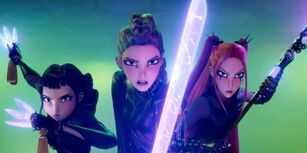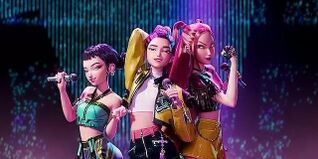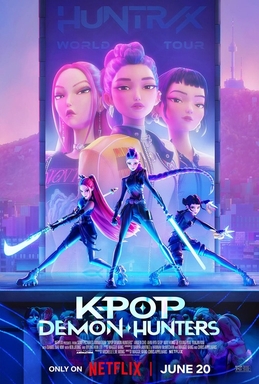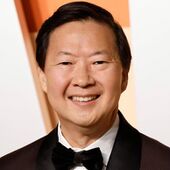KPop Demon Hunters: Difference between revisions
Adding Images, highlight Texts, Captions, infobox, cast section |
mNo edit summary |
||
| (7 intermediate revisions by 2 users not shown) | |||
| Line 1: | Line 1: | ||
{{Info|name=KPop Demon Hunters|image=KPop Demon Hunters.jpg|image_size=280px|caption=Release Poster|heading=KPop Demon Hunters|directed by=Maggie Kang | {{Info|name=KPop Demon Hunters|image=KPop Demon Hunters.jpg|image_size=280px|caption=Release Poster|heading=KPop Demon Hunters|directed by=Maggie Kang, | ||
Chris Appelhans|screenplay by=Danya Jimenez | Chris Appelhans|screenplay by=Danya Jimenez | ||
Hannah McMechan | Hannah McMechan | ||
| Line 21: | Line 21: | ||
Centuries ago, demons terrorized humans, feeding their souls to their ruler, '''Gwi-Ma'''. In response, three women emerged as demon hunters, using their singing to conjure a magical shield known as the '''Honmoon'''. Over time, new generations of hunters maintained the Honmoon, striving to eventually create the '''Golden Honmoon''', a powerful seal capable of banishing demons for good.<br> | Centuries ago, demons terrorized humans, feeding their souls to their ruler, '''Gwi-Ma'''. In response, three women emerged as demon hunters, using their singing to conjure a magical shield known as the '''Honmoon'''. Over time, new generations of hunters maintained the Honmoon, striving to eventually create the '''Golden Honmoon''', a powerful seal capable of banishing demons for good.<br> | ||
In the present day, the K-pop girl group Huntr/x, consisting of Rumi, Mira, and Zoey, carries on the legacy as the latest trio of hunters under the guidance of former hunter Celine. Rumi secretly harbors demonic blood, a truth only she and Celine know. As her demonic markings slowly appear on her skin, Rumi hopes that the release and live debut of their new single, | In the present day, the K-pop girl group '''Huntr/x''', consisting of '''Rumi''', '''Mira''', and '''Zoey''', carries on the legacy as the latest trio of hunters under the guidance of former hunter '''Celine'''. Rumi secretly harbors demonic blood, a truth only she and Celine know. As her demonic markings slowly appear on her skin, '''Rumi''' hopes that the release and live debut of their new single, “'''Golden'''”, will transform the Honmoon into its golden form and erase her affliction. But she struggles when her voice starts failing at a critical moment.<br> | ||
Meanwhile, in the demon realm, Gwi-Ma grows furious over repeated failures. Five demons, led by the former human Jinu, form the boy band Saja Boys to siphon Huntr/x’s fans and weaken the Honmoon, with the promise that Gwi-Ma will erase Jinu’s human memories. After a variety show encounter, Huntr/x discover the Saja Boys’ demonic identity. Jinu notices Rumi’s markings but conceals them, sharing that feelings of shame can enslave demons through Gwi-Ma’s influence. He reveals his own tragic past: granted a voice that brought his family success, he was condemned to the demon realm and lives with guilt over their downfall.<br> | Meanwhile, in the demon realm, '''Gwi-Ma''' grows furious over repeated failures. Five demons, led by the former human '''Jinu''', form the boy band '''Saja Boys''' to siphon Huntr/x’s fans and weaken the Honmoon, with the promise that Gwi-Ma will erase Jinu’s human memories. After a variety show encounter, '''Huntr/x''' discover the Saja Boys’ demonic identity. Jinu notices Rumi’s markings but conceals them, sharing that feelings of shame can enslave demons through '''Gwi-Ma’s''' influence. He reveals his own tragic past: granted a voice that brought his family success, he was condemned to the demon realm and lives with guilt over their downfall.<br> | ||
As the Saja Boys rise in popularity, the Honmoon weakens, increasing demon attacks. Preparing for the Idol Awards, Huntr/x write a new song, | As the Saja Boys rise in popularity, the '''Honmoon''' weakens, increasing demon attacks. Preparing for the '''Idol Awards''', Huntr/x write a new song, “'''Takedown'''”, to expose their rivals. Rumi struggles with the song’s harsh lyrics, straining her bond with Mira and Zoey. She enlists Jinu’s help, promising that victory would allow him to remain in the human world. Their collaboration restores Rumi’s voice, previously dampened by shame, while Jinu agrees to undermine the '''Saja Boys'''. | ||
At the awards, Huntr/x perform “Golden”, shelving “Takedown”. However, impostor demons manipulate the stage, revealing Rumi’s patterns and separating her from Mira and Zoey. Betrayed and furious, the trio confront Jinu, who admits deceiving Rumi. Gwi-Ma, empowered by weakened defenses, casts a trance over the audience, including Huntr/x, drawing them to the Saja Boys’ performance.<br> | At the awards, '''Huntr/x''' perform “Golden”, shelving “Takedown”. However, impostor demons manipulate the stage, revealing Rumi’s patterns and separating her from Mira and Zoey. Betrayed and furious, the trio confront Jinu, who admits deceiving Rumi. Gwi-Ma, empowered by weakened defenses, casts a trance over the audience, including Huntr/x, drawing them to the Saja Boys’ performance.<br> | ||
In a moment of desperation, Rumi refuses Celine’s offer to end her life and instead faces Gwi-Ma with newfound courage. She interrupts the Saja Boys’ concert with a heartfelt song about self-acceptance, breaking the trance and reuniting Huntr/x. Jinu redeems himself, sacrificing his restored soul to protect Rumi. Strengthened, Huntr/x defeat Gwi-Ma and the remaining demons, forging a new Honmoon. | '''In a moment of desperation''', Rumi refuses Celine’s offer to end her life and instead faces Gwi-Ma with newfound courage. She interrupts the Saja Boys’ concert with a heartfelt song about self-acceptance, breaking the trance and reuniting Huntr/x. Jinu redeems himself, sacrificing his restored soul to protect Rumi. Strengthened, Huntr/x defeat Gwi-Ma and the remaining '''demons''', forging a new '''Honmoon'''. | ||
With her demonic heritage embraced, Rumi celebrates with Mira and Zoey, reconnecting with both each other and their fans, ready to continue their dual lives as idols and defenders. | With her demonic heritage embraced, Rumi celebrates with Mira and Zoey, reconnecting with both each other and their fans, ready to continue their dual lives as idols and defenders. | ||
| Line 97: | Line 97: | ||
== Production == | == Production == | ||
=== Development === | === Development === | ||
In March 2021, Sony Pictures Animation announced an animated film initially titled K-Pop: Demon Hunters, directed by Maggie Kang and Chris Appelhans, with Hannah McMechan and Danya Jimenez co-writing the screenplay. Aron Warner and Michelle L. M. Wong produced, while Mingjue Helen Chen and Ami Thompson handled production design and art direction.<br> | '''In March 2021''', Sony Pictures Animation announced an animated film initially titled K-Pop: Demon Hunters, directed by '''Maggie Kang''' and '''Chris Appelhans''', with '''Hannah McMechan''' and '''Danya Jimenez''' co-writing the screenplay. '''Aron Warner''' and '''Michelle L. M. Wong produced''', while '''Mingjue Helen Chen''' and '''Ami Thompson''' handled production design and art direction.<br> | ||
The project stemmed from Kang’s desire to celebrate Korean culture through mythology, demonology, and K-pop. She envisioned a world where female heroes use music as a weapon, inspired by shaman women who historically protected communities through song and dance. Kang aimed for characters who felt real and playful, avoiding typical superhero stereotypes, while drawing on the tonal mastery of Bong Joon Ho for blending genres and moods.Appelhans joined to explore music’s power to unite and bring joy, while McMechan and Jimenez brought youthful perspective and energy despite limited familiarity with animation or K-pop.<br> | The project stemmed from Kang’s desire to celebrate '''Korean culture''' through mythology, demonology, and '''K-pop'''. She envisioned a world where female heroes use music as a weapon, inspired by shaman women who historically protected communities through song and dance. Kang aimed for characters who felt real and playful, avoiding typical superhero stereotypes, while drawing on the tonal mastery of '''Bong Joon Ho''' for blending genres and moods.Appelhans joined to explore music’s power to unite and bring joy, while '''McMechan''' and '''Jimenez''' brought youthful perspective and energy despite limited familiarity with '''animation''' or '''K-pop'''.<br> | ||
[[File:Demon4.jpg|left|thumb|307x307px|Kpop Demon Hunters creator excited at potential for more stories.]] | [[File:Demon4.jpg|left|thumb|307x307px|Kpop Demon Hunters creator excited at potential for more stories.]] | ||
The girl group Huntr/x takes its name from | The girl group Huntr/x takes its name from “'''hunter'''” combined with the Latin feminine suffix “-trix.” The trio’s design was influenced by K-pop groups such as '''Itzy''', '''Blackpink''', and '''Twice''', with '''Mira modeled''' after Korean model '''Ahn So-yeon'''. The rival Saja Boys drew inspiration from BTS, TXT, and BigBang, with leader Jinu inspired by actor-singer '''Cha Eun-woo.''' Their name references both the Korean “grim reaper” (jeoseung saja) and the word for lion, reflected in the group’s logo and their fandom, called “'''the Pride'''.”<br> | ||
The visual style fuses historical and modern Korean elements. Huntr/x wear modernized norigae pendants, while the Saja Boys perform in traditional hanbok. Costumes and weapons were designed to support the story, from the gold outfits in the “Golden” song symbolizing ambition to Rumi’s transformation reflecting the shattering of ideals. | The visual style fuses historical and modern Korean elements. '''Huntr/x''' wear modernized norigae pendants, while the '''Saja Boys''' perform in traditional hanbok. Costumes and weapons were designed to support the story, from the gold outfits in the “Golden” song symbolizing ambition to Rumi’s transformation reflecting the shattering of ideals. | ||
=== Animations === | === Animations === | ||
The animation for KPop Demon Hunters was produced by Sony Pictures Imageworks across their Vancouver and Montreal studios, with Josh Beveridge leading character animation. The visual style drew inspiration from music videos, editorial photography, K-dramas, concert lighting, and anime, blending 2D aesthetics with 3D animation to create a bold, graphic look. The team aimed for expressive characters, adjusting facial features to match different tones—from glamorous pop-star moments, to intense action sequences, to exaggerated “Chibi” scenes with playful, over-the-top expressions. Efforts were also made to authentically represent Korean identity, including unique mouth and eye shapes inspired by Korean speech and facial structure, even though the dialogue is in English.<br> | The animation for KPop Demon Hunters was produced by '''Sony Pictures Imageworks''' across their Vancouver and Montreal studios, with '''Josh Beveridge''' leading character animation. The visual style drew inspiration from '''music videos, editorial photography, K-dramas, concert lighting, and anime,''' blending 2D aesthetics with 3D animation to create a bold, graphic look. The team aimed for expressive characters, adjusting facial features to match different tones—from glamorous pop-star moments, to intense action sequences, to exaggerated “Chibi” scenes with playful, over-the-top expressions. Efforts were also made to authentically represent '''Korean identity''', including unique mouth and eye shapes inspired by Korean speech and facial structure, even though the dialogue is in English.<br> | ||
[[File:Demon2.jpg|thumb|318x318px|''A still from'' KPop Demon Hunters ''featuring the members of Huntrix. The animation blends Korean cultural motifs with modern digital artistry.'']] | [[File:Demon2.jpg|thumb|318x318px|''A still from'' KPop Demon Hunters ''featuring the members of Huntrix. The animation blends Korean cultural motifs with modern digital artistry.'']] | ||
The film’s animal characters were deeply influenced by minhwa, traditional Korean folk art. Jinu’s pet tiger and magpie, nicknamed Derpy and Sussie, reflect this style, which often combines whimsy and satire. Minhwa, particularly the Hojak-do genre, depicts tigers, magpies, and pine trees in humorous ways, sometimes poking fun at authority. The creative team incorporated these traditions playfully, such as the magpie stealing the tiger’s hat. Derpy’s bright blue coloring originated from production designer Helen Mingjue Chen, giving the tiger a magical quality, while Sussie’s six eyes add a fantastical touch.<br> | The film’s animal characters were deeply influenced by '''minhwa''', traditional Korean folk art. Jinu’s pet tiger and magpie, nicknamed '''Derpy''' and '''Sussie''', reflect this style, which often combines whimsy and satire. Minhwa, particularly the '''Hojak-do genre''', depicts tigers, magpies, and pine trees in humorous ways, sometimes poking fun at authority. The creative team incorporated these traditions playfully, such as the magpie stealing the tiger’s hat. Derpy’s bright blue coloring originated from production designer '''Helen Mingjue Chen''', giving the tiger a magical quality, while Sussie’s six eyes add a fantastical touch.<br> | ||
Originally, Derpy was conceived simply as a fun companion, but the team developed him into a functional part of the story, acting as a communication device for the characters, with the magpie accompanying him. Kang emphasized that while the animals exist between the human and demon worlds, they are not themselves demons, leaving an element of mystery in their presence. | Originally, Derpy was conceived simply as a fun companion, but the team developed him into a functional part of the story, acting as a communication device for the characters, with the magpie accompanying him. Kang emphasized that while the animals exist between the human and demon worlds, they are '''not themselves demons''', leaving an element of mystery in their presence. | ||
== Reception == | == Reception == | ||
=== Box office === | === Box office === | ||
The sing-along edition of KPop Demon Hunters hit theaters on August 23, 2025, opening in 1,700 locations and surpassing Netflix’s Glass Onion: A Knives Out Mystery, which had played in 698 theaters. Initial forecasts predicted an opening weekend of $18–20 million, and the film ultimately earned $19.2 million in the U.S. and Canada, becoming Netflix’s highest-grossing theatrical release to date. This marked the first time a Netflix film claimed the top spot at the domestic box office.<br> | The '''sing-along edition''' of KPop Demon Hunters hit theaters on '''August 23, 2025''', opening in '''1,700 locations''' and surpassing Netflix’s Glass Onion: A Knives Out Mystery, which had played in 698 theaters. Initial forecasts predicted an opening weekend of '''$18–20 million,''' and the film ultimately earned '''$19.2 million in the U.S. and Canada''', becoming Netflix’s highest-grossing theatrical release to date. This marked the first time a Netflix film claimed the top spot at the domestic box office.<br> | ||
Industry analysts noted that the film performed strongly despite already being available on streaming. Jeremy Fuster of TheWrap suggested that a traditional theatrical release could have pushed domestic earnings closer to $100 million. Matt Schimkowitz of The A.V. Club observed that many viewers attending the theatrical screenings had likely already streamed the movie at home. Ben Fritz of The Wall Street Journal highlighted that critical acclaim motivated Netflix to pursue a wider theatrical rollout, making it a rare and noteworthy release for the platform. | Industry analysts noted that the film performed strongly despite already being available on streaming. '''Jeremy Fuster of TheWrap''' suggested that a traditional theatrical release could have pushed domestic earnings closer to '''$100 million. Matt Schimkowitz of The A.V. Club''' observed that many viewers attending the theatrical screenings had likely already streamed the movie at home. '''Ben Fritz of The Wall Street Journal''' highlighted that critical acclaim motivated Netflix to pursue a wider theatrical rollout, making it a rare and noteworthy release for the platform. | ||
=== Critical response === | === Critical response === | ||
KPop Demon Hunters was met with widespread praise from critics and audiences alike, who lauded its animation, storytelling, music, and voice performances. On Rotten Tomatoes, 95% of 86 reviews were positive, with an average score of 7.8/10, while Metacritic assigned a score of 77/100, reflecting generally favorable reviews.<br> | KPop Demon Hunters was met with widespread praise from critics and audiences alike, who lauded its animation, storytelling, music, and voice performances. On '''Rotten Tomatoes''', 95% of 86 reviews were positive, with an average score of 7.8/10, while '''Metacritic''' assigned a score of 77/100, reflecting generally favorable reviews.<br> | ||
[[File:Demon3.jpg|left|thumb|''Scene from'' KPop Demon Hunters, ''which received critical acclaim for its animation, music, and cultural representation.'']] | [[File:Demon3.jpg|left|thumb|''Scene from'' KPop Demon Hunters, ''which received critical acclaim for its animation, music, and cultural representation.'']] | ||
Reviewers highlighted the film’s inventive world-building and humor. The New York Times described it as “a charming and punchy universe,” particularly noting its sharp satire of manufactured pop culture, from K-pop to reality singing competitions. TheWrap emphasized that comedic elements balanced the dramatic narrative, and the directors were praised for maintaining genuine stakes within an exaggerated setting. The Korea Times commended its nuanced portrayal of Korean culture, calling it both a love letter to K-pop and a thoughtful exploration of the surrounding cultural context. Critics also compared its visual dynamism to the Spider-Verse films, noting fluid action, striking art, and the use of music as a storytelling device.<br> | Reviewers highlighted the film’s inventive world-building and humor. '''The New York Times''' described it as “a charming and punchy universe,” particularly noting its sharp satire of manufactured pop culture, from K-pop to reality singing competitions. '''TheWrap''' emphasized that comedic elements balanced the dramatic narrative, and the directors were praised for maintaining genuine stakes within an exaggerated setting. '''The Korea Times''' commended its nuanced portrayal of Korean culture, calling it both a love letter to K-pop and a thoughtful exploration of the surrounding cultural context. Critics also compared its visual dynamism to the Spider-Verse films, noting fluid action, striking art, and the use of music as a storytelling device.<br> | ||
Voice acting received strong recognition. Arden Cho was highlighted for her layered performance as Rumi, while May Hong and Ji-young Yoo brought distinct personalities to Mira and Zoey. Ahn Hyo-seop was praised for his charismatic portrayal of Jinu. The film’s music was celebrated for being integral to the plot, with songs staged in inventive | Voice acting received strong recognition. '''Arden Cho''' was highlighted for her layered performance as Rumi, while '''May Hong''' and '''Ji-young Yoo''' brought distinct personalities to Mira and Zoey. '''Ahn Hyo-seop''' was praised for his charismatic portrayal of Jinu. The film’s music was celebrated for being integral to the plot, with songs staged in inventive ways, ranging from demon-fight sequences to high-energy dance numbers and montage scenes, blending K-pop spectacle with narrative purpose.<br> | ||
Animation and supporting elements, such as the tiger and magpie sidekicks, were praised for their cultural homage to Korean folk art. While some reviewers noted the film’s short runtime resulted in underdeveloped subplots and a slightly rushed climax, the overall reception was overwhelmingly positive. Critics described it as a visually dazzling, musically vibrant, and culturally rich film that has become a major animated success for Netflix, positioning it as a potential billion-dollar franchise. | Animation and supporting elements, such as the '''tiger''' and '''magpie sidekicks''', were praised for their cultural homage to '''Korean folk art'''. While some reviewers noted the film’s '''short runtime''' resulted in underdeveloped subplots and a slightly rushed '''climax''', the overall reception was overwhelmingly positive. Critics described it as a visually dazzling, musically vibrant, and culturally rich film that has become a major animated success for '''Netflix''', positioning it as a potential billion-dollar franchise. | ||
=== Accolades === | === Accolades === | ||
| Line 161: | Line 161: | ||
== Impact == | == Impact == | ||
By late July 2025, Netflix announced that KPop Demon Hunters had become the streaming platform’s most-watched original animated feature. By August 26, the film had reportedly been viewed 236 million times, surpassing Red Notice (2021) to claim the top spot among Netflix originals. Its momentum continued, and by September 3, the film had accumulated over 266 million streams, overtaking the first season of Squid Game (2021) as Netflix’s most-watched title.<br> | By late '''July 2025''', Netflix announced that KPop Demon Hunters had become the streaming platform’s most-watched original animated feature. By August 26, the film had reportedly been viewed '''236 million times''', surpassing Red Notice (2021) to claim the top spot among Netflix originals. Its momentum continued, and by '''September 3''', the film had accumulated over '''266 million streams''', overtaking the first season of Squid Game (2021) as Netflix’s most-watched title.<br> | ||
The film’s popularity surprised many industry observers, with some likening its breakout success to Disney’s Encanto (2021). The soundtrack and merchandising also played a major role in its cultural reach, with Netflix’s official store listing film-themed apparel and plush toys among the top-selling items of the year. Critics and analysts described KPop Demon Hunters as a global sensation, an unexpected hit, and a highly profitable property for Netflix, highlighting its wide appeal and cross-generational draw.<br> | The film’s popularity surprised many industry observers, with some likening its breakout success to '''Disney’s Encanto (2021)'''. The '''soundtrack and merchandising''' also played a major role in its cultural reach, with Netflix’s official store listing film-themed apparel and plush toys among the top-selling items of the year. Critics and analysts described KPop Demon Hunters as a global sensation, an unexpected hit, and a highly profitable property for Netflix, highlighting its wide appeal and cross-generational draw.<br> | ||
[[File:Demon1.jpg|thumb|''KPop Demon Hunters became Netflix’s most-watched title, surpassing'' Squid Game ''and'' Red Notice.]] | [[File:Demon1.jpg|thumb|''KPop Demon Hunters became Netflix’s most-watched title, surpassing'' Squid Game ''and'' Red Notice.]] | ||
In South Korea, the film’s success translated into a boost for tourism and pop culture engagement. Fans visited locations featured in the film, including Namsan, Naksan Park Fortress Trail, and Bukchon Hanok Village, while themed products and | In '''South Korea''', the film’s success translated into a boost for tourism and pop culture engagement. Fans visited locations featured in the film, including '''Namsan, Naksan Park Fortress Trail, and Bukchon Hanok Village''', while themed products and experiences such as cafés and museum shops saw increased attention. Local authorities reported that international visitors to Seoul rose by '''23.1%''' compared to July 2024, marking a record monthly high. Observers noted that the film’s influence extended to culinary trends and cultural programs, with art classes and workshops inspired by its characters and themes.<br> | ||
The soundtrack achieved remarkable success worldwide, with multiple singles charting in top positions across markets. The song “Golden” remained the No. 1 single in the U.K. for six consecutive weeks and contributed to seven tracks from the film appearing in the Billboard top 20 simultaneously. The film also permeated popular culture beyond music, with references appearing at the U.S. Open, on Saturday Night Live, and on The Tonight Show with Jimmy Fallon, where live performances of the film’s songs further amplified its global impact. | The soundtrack achieved remarkable success worldwide, with multiple singles charting in top positions across markets. The song '''“Golden”''' remained the '''No. 1 single in the U.K.''' for six consecutive weeks and contributed to seven tracks from the film appearing in the Billboard top 20 simultaneously. The film also permeated popular culture beyond music, with references appearing at the U.S. Open, on Saturday Night Live, and on The '''Tonight Show''' with '''Jimmy Fallon,''' where live performances of the film’s songs further amplified its global impact. | ||
=== Fandom === | === Fandom === | ||
KPop Demon Hunters has been widely recognized as a cultural phenomenon, with media outlets praising its music, characters, narrative, and nods to anime, as well as its representation of Asian culture and fandom communities. The film inspired a surge of online activity, including viral dance trends on TikTok, a flood of fanart, and active discussions across social media. Within South Korea, fans coined the term “KeDeHun” for the film’s enthusiastic following.<br> | '''KPop Demon Hunters''' has been widely recognized as a cultural phenomenon, with media outlets praising its music, characters, narrative, and nods to anime, as well as its representation of Asian culture and fandom communities. The film inspired a surge of online activity, including viral dance trends on '''TikTok''', a flood of fanart, and active discussions across social media. Within '''South Korea''', fans coined the term '''“KeDeHun”''' for the film’s enthusiastic following.<br> | ||
[[File:Domonfans.jpg|left|thumb|Scenes From the 'KPop Demon Hunters' Singalong at NYC's Paris Theater]] | [[File:Domonfans.jpg|left|thumb|Scenes From the 'KPop Demon Hunters' Singalong at NYC's Paris Theater]] | ||
BBC News highlighted that the film sparked K-pop-themed dance classes in Belfast, noting that the movie helped make K-pop more visible to global audiences. Alex Vadukul of The New York Times reported on the intense fan devotion to Huntr/x and the Saja Boys, with voice actress May Hong describing the experience as overwhelming due to the fervent reception. Yvonne Kim of The Atlantic observed that the film elevates fandom from a simple hobby into an act of creativity, exploring the complex dynamics between performers and fans while emphasizing the dedication of those who engage with K-pop culture.<br> | '''BBC News highlighted''' that the film sparked K-pop-themed dance classes in Belfast, noting that the movie helped make K-pop more visible to global audiences. Alex Vadukul of '''The New York Times''' reported on the intense fan devotion to '''Huntr/x''' and the '''Saja Boys''', with voice actress May Hong describing the experience as overwhelming due to the fervent reception. '''Yvonne Kim''' of The Atlantic observed that the film elevates fandom from a simple hobby into an act of creativity, exploring the complex dynamics between performers and fans while emphasizing the dedication of those who engage with '''K-pop culture'''.<br> | ||
The film also inspired a viral internet challenge involving ramen noodles, referencing a scene where Rumi, Zoey | The film also inspired a viral internet challenge involving '''ramen noodles''', referencing a scene where '''Rumi, Zoey''' and '''Mira''' eat ramyun while performing '''“How It’s Done.”''' Unfortunately, some participants attempting to replicate the scene suffered burns, leading hospitals and medical professionals to caution fans about the dangers of handling boiling water, urging careful preparation to avoid injury. | ||
== Future == | |||
=== Short Film === | |||
'''On March 29, 2023''', '''Sony''' announced that its LENS mentorship program would develop a short film inspired by '''KPop Demon Hunters''', following the release of The Spider Within, a Spider-Verse spin-off short. '''In September 2025''', the short titled Debut: A KPop Demon Hunters Story, received a PG rating from the '''Motion Picture Association (MPA).''' | |||
=== Other Media === | |||
'''Rumi''', '''Mira''', and '''Zoey''' were added to the video game '''Fortnite''' as purchaseable skins on '''October 2, 2025'''. | |||
Latest revision as of 11:27, 16 October 2025
KPop Demon Hunters is a 2025 American animated musical urban fantasy film directed by Maggie Kang and Chris Appelhans, who co-wrote the screenplay with Danya Jimenez and Hannah McMechan. Produced by Sony Pictures Animation for Netflix, the film features the voices of Arden Cho, Ahn Hyo-seop, May Hong, Ji-young Yoo, Yunjin Kim, Daniel Dae Kim, Ken Jeong, and Lee Byung-hun.
The story centers on Huntr/x, a world-famous K-pop girl group who secretly live double lives as demon hunters. When they encounter a rival boy band, the Saja Boys, their glamorous world collides with a hidden war against demonic forces threatening humanity.Inspired by Maggie Kang’s Korean heritage, the film blends modern pop culture with traditional mythology, reimagining Seoul as a neon-lit battleground of music, fame, and folklore.The animation, crafted by Sony Pictures Imageworks, draws from concert lighting, editorial photography, anime, and K-dramas, creating a dazzling visual experience that mirrors the spectacle of a live performance. The score by Marcelo Zarvos, combined with original K-pop-inspired songs, became a global sensation.
Released on June 20, 2025, the film became an instant phenomenon, topping charts and breaking records as Netflix’s most-watched original film with over 325 million views. Its sing-along theatrical edition (August 23–24, 2025) marked the first Netflix release to top the U.S. box office, surpassing Glass Onion: A Knives Out Mystery. Acclaimed for its animation, cultural depth, and soundtrack, KPop Demon Hunters was hailed as a vibrant celebration of Korean creativity. A sequel and a short film titled Debut: A KPop Demon Hunters Story are already in development, expanding the franchise’s universe.
Plot
Centuries ago, demons terrorized humans, feeding their souls to their ruler, Gwi-Ma. In response, three women emerged as demon hunters, using their singing to conjure a magical shield known as the Honmoon. Over time, new generations of hunters maintained the Honmoon, striving to eventually create the Golden Honmoon, a powerful seal capable of banishing demons for good.
In the present day, the K-pop girl group Huntr/x, consisting of Rumi, Mira, and Zoey, carries on the legacy as the latest trio of hunters under the guidance of former hunter Celine. Rumi secretly harbors demonic blood, a truth only she and Celine know. As her demonic markings slowly appear on her skin, Rumi hopes that the release and live debut of their new single, “Golden”, will transform the Honmoon into its golden form and erase her affliction. But she struggles when her voice starts failing at a critical moment.
Meanwhile, in the demon realm, Gwi-Ma grows furious over repeated failures. Five demons, led by the former human Jinu, form the boy band Saja Boys to siphon Huntr/x’s fans and weaken the Honmoon, with the promise that Gwi-Ma will erase Jinu’s human memories. After a variety show encounter, Huntr/x discover the Saja Boys’ demonic identity. Jinu notices Rumi’s markings but conceals them, sharing that feelings of shame can enslave demons through Gwi-Ma’s influence. He reveals his own tragic past: granted a voice that brought his family success, he was condemned to the demon realm and lives with guilt over their downfall.
As the Saja Boys rise in popularity, the Honmoon weakens, increasing demon attacks. Preparing for the Idol Awards, Huntr/x write a new song, “Takedown”, to expose their rivals. Rumi struggles with the song’s harsh lyrics, straining her bond with Mira and Zoey. She enlists Jinu’s help, promising that victory would allow him to remain in the human world. Their collaboration restores Rumi’s voice, previously dampened by shame, while Jinu agrees to undermine the Saja Boys.
At the awards, Huntr/x perform “Golden”, shelving “Takedown”. However, impostor demons manipulate the stage, revealing Rumi’s patterns and separating her from Mira and Zoey. Betrayed and furious, the trio confront Jinu, who admits deceiving Rumi. Gwi-Ma, empowered by weakened defenses, casts a trance over the audience, including Huntr/x, drawing them to the Saja Boys’ performance.
In a moment of desperation, Rumi refuses Celine’s offer to end her life and instead faces Gwi-Ma with newfound courage. She interrupts the Saja Boys’ concert with a heartfelt song about self-acceptance, breaking the trance and reuniting Huntr/x. Jinu redeems himself, sacrificing his restored soul to protect Rumi. Strengthened, Huntr/x defeat Gwi-Ma and the remaining demons, forging a new Honmoon. With her demonic heritage embraced, Rumi celebrates with Mira and Zoey, reconnecting with both each other and their fans, ready to continue their dual lives as idols and defenders.
Cast
Production
Development
In March 2021, Sony Pictures Animation announced an animated film initially titled K-Pop: Demon Hunters, directed by Maggie Kang and Chris Appelhans, with Hannah McMechan and Danya Jimenez co-writing the screenplay. Aron Warner and Michelle L. M. Wong produced, while Mingjue Helen Chen and Ami Thompson handled production design and art direction.
The project stemmed from Kang’s desire to celebrate Korean culture through mythology, demonology, and K-pop. She envisioned a world where female heroes use music as a weapon, inspired by shaman women who historically protected communities through song and dance. Kang aimed for characters who felt real and playful, avoiding typical superhero stereotypes, while drawing on the tonal mastery of Bong Joon Ho for blending genres and moods.Appelhans joined to explore music’s power to unite and bring joy, while McMechan and Jimenez brought youthful perspective and energy despite limited familiarity with animation or K-pop.

The girl group Huntr/x takes its name from “hunter” combined with the Latin feminine suffix “-trix.” The trio’s design was influenced by K-pop groups such as Itzy, Blackpink, and Twice, with Mira modeled after Korean model Ahn So-yeon. The rival Saja Boys drew inspiration from BTS, TXT, and BigBang, with leader Jinu inspired by actor-singer Cha Eun-woo. Their name references both the Korean “grim reaper” (jeoseung saja) and the word for lion, reflected in the group’s logo and their fandom, called “the Pride.”
The visual style fuses historical and modern Korean elements. Huntr/x wear modernized norigae pendants, while the Saja Boys perform in traditional hanbok. Costumes and weapons were designed to support the story, from the gold outfits in the “Golden” song symbolizing ambition to Rumi’s transformation reflecting the shattering of ideals.
Animations
The animation for KPop Demon Hunters was produced by Sony Pictures Imageworks across their Vancouver and Montreal studios, with Josh Beveridge leading character animation. The visual style drew inspiration from music videos, editorial photography, K-dramas, concert lighting, and anime, blending 2D aesthetics with 3D animation to create a bold, graphic look. The team aimed for expressive characters, adjusting facial features to match different tones—from glamorous pop-star moments, to intense action sequences, to exaggerated “Chibi” scenes with playful, over-the-top expressions. Efforts were also made to authentically represent Korean identity, including unique mouth and eye shapes inspired by Korean speech and facial structure, even though the dialogue is in English.

The film’s animal characters were deeply influenced by minhwa, traditional Korean folk art. Jinu’s pet tiger and magpie, nicknamed Derpy and Sussie, reflect this style, which often combines whimsy and satire. Minhwa, particularly the Hojak-do genre, depicts tigers, magpies, and pine trees in humorous ways, sometimes poking fun at authority. The creative team incorporated these traditions playfully, such as the magpie stealing the tiger’s hat. Derpy’s bright blue coloring originated from production designer Helen Mingjue Chen, giving the tiger a magical quality, while Sussie’s six eyes add a fantastical touch.
Originally, Derpy was conceived simply as a fun companion, but the team developed him into a functional part of the story, acting as a communication device for the characters, with the magpie accompanying him. Kang emphasized that while the animals exist between the human and demon worlds, they are not themselves demons, leaving an element of mystery in their presence.
Reception
Box office
The sing-along edition of KPop Demon Hunters hit theaters on August 23, 2025, opening in 1,700 locations and surpassing Netflix’s Glass Onion: A Knives Out Mystery, which had played in 698 theaters. Initial forecasts predicted an opening weekend of $18–20 million, and the film ultimately earned $19.2 million in the U.S. and Canada, becoming Netflix’s highest-grossing theatrical release to date. This marked the first time a Netflix film claimed the top spot at the domestic box office.
Industry analysts noted that the film performed strongly despite already being available on streaming. Jeremy Fuster of TheWrap suggested that a traditional theatrical release could have pushed domestic earnings closer to $100 million. Matt Schimkowitz of The A.V. Club observed that many viewers attending the theatrical screenings had likely already streamed the movie at home. Ben Fritz of The Wall Street Journal highlighted that critical acclaim motivated Netflix to pursue a wider theatrical rollout, making it a rare and noteworthy release for the platform.
Critical response
KPop Demon Hunters was met with widespread praise from critics and audiences alike, who lauded its animation, storytelling, music, and voice performances. On Rotten Tomatoes, 95% of 86 reviews were positive, with an average score of 7.8/10, while Metacritic assigned a score of 77/100, reflecting generally favorable reviews.

Reviewers highlighted the film’s inventive world-building and humor. The New York Times described it as “a charming and punchy universe,” particularly noting its sharp satire of manufactured pop culture, from K-pop to reality singing competitions. TheWrap emphasized that comedic elements balanced the dramatic narrative, and the directors were praised for maintaining genuine stakes within an exaggerated setting. The Korea Times commended its nuanced portrayal of Korean culture, calling it both a love letter to K-pop and a thoughtful exploration of the surrounding cultural context. Critics also compared its visual dynamism to the Spider-Verse films, noting fluid action, striking art, and the use of music as a storytelling device.
Voice acting received strong recognition. Arden Cho was highlighted for her layered performance as Rumi, while May Hong and Ji-young Yoo brought distinct personalities to Mira and Zoey. Ahn Hyo-seop was praised for his charismatic portrayal of Jinu. The film’s music was celebrated for being integral to the plot, with songs staged in inventive ways, ranging from demon-fight sequences to high-energy dance numbers and montage scenes, blending K-pop spectacle with narrative purpose.
Animation and supporting elements, such as the tiger and magpie sidekicks, were praised for their cultural homage to Korean folk art. While some reviewers noted the film’s short runtime resulted in underdeveloped subplots and a slightly rushed climax, the overall reception was overwhelmingly positive. Critics described it as a visually dazzling, musically vibrant, and culturally rich film that has become a major animated success for Netflix, positioning it as a potential billion-dollar franchise.
Accolades
| Award | Date of ceremony | Category | Recipient(s) | Result |
|---|---|---|---|---|
| K-World Dream Awards | August 21, 2025 | Best OST | "Golden" | Won |
| K-World Dream Awards | August 21, 2025 | Best OST | "Soda Pop" | Nominated |
| MTV Video Music Awards | September 7, 2025 | Song of Summer | "Golden" | Nominated |
| Celebration of Asian Pacific Cinema and Television | November 14, 2025 | Animation Award | Maggie Kang | Won |
Impact
By late July 2025, Netflix announced that KPop Demon Hunters had become the streaming platform’s most-watched original animated feature. By August 26, the film had reportedly been viewed 236 million times, surpassing Red Notice (2021) to claim the top spot among Netflix originals. Its momentum continued, and by September 3, the film had accumulated over 266 million streams, overtaking the first season of Squid Game (2021) as Netflix’s most-watched title.
The film’s popularity surprised many industry observers, with some likening its breakout success to Disney’s Encanto (2021). The soundtrack and merchandising also played a major role in its cultural reach, with Netflix’s official store listing film-themed apparel and plush toys among the top-selling items of the year. Critics and analysts described KPop Demon Hunters as a global sensation, an unexpected hit, and a highly profitable property for Netflix, highlighting its wide appeal and cross-generational draw.

In South Korea, the film’s success translated into a boost for tourism and pop culture engagement. Fans visited locations featured in the film, including Namsan, Naksan Park Fortress Trail, and Bukchon Hanok Village, while themed products and experiences such as cafés and museum shops saw increased attention. Local authorities reported that international visitors to Seoul rose by 23.1% compared to July 2024, marking a record monthly high. Observers noted that the film’s influence extended to culinary trends and cultural programs, with art classes and workshops inspired by its characters and themes.
The soundtrack achieved remarkable success worldwide, with multiple singles charting in top positions across markets. The song “Golden” remained the No. 1 single in the U.K. for six consecutive weeks and contributed to seven tracks from the film appearing in the Billboard top 20 simultaneously. The film also permeated popular culture beyond music, with references appearing at the U.S. Open, on Saturday Night Live, and on The Tonight Show with Jimmy Fallon, where live performances of the film’s songs further amplified its global impact.
Fandom
KPop Demon Hunters has been widely recognized as a cultural phenomenon, with media outlets praising its music, characters, narrative, and nods to anime, as well as its representation of Asian culture and fandom communities. The film inspired a surge of online activity, including viral dance trends on TikTok, a flood of fanart, and active discussions across social media. Within South Korea, fans coined the term “KeDeHun” for the film’s enthusiastic following.

BBC News highlighted that the film sparked K-pop-themed dance classes in Belfast, noting that the movie helped make K-pop more visible to global audiences. Alex Vadukul of The New York Times reported on the intense fan devotion to Huntr/x and the Saja Boys, with voice actress May Hong describing the experience as overwhelming due to the fervent reception. Yvonne Kim of The Atlantic observed that the film elevates fandom from a simple hobby into an act of creativity, exploring the complex dynamics between performers and fans while emphasizing the dedication of those who engage with K-pop culture.
The film also inspired a viral internet challenge involving ramen noodles, referencing a scene where Rumi, Zoey and Mira eat ramyun while performing “How It’s Done.” Unfortunately, some participants attempting to replicate the scene suffered burns, leading hospitals and medical professionals to caution fans about the dangers of handling boiling water, urging careful preparation to avoid injury.
Future
Short Film
On March 29, 2023, Sony announced that its LENS mentorship program would develop a short film inspired by KPop Demon Hunters, following the release of The Spider Within, a Spider-Verse spin-off short. In September 2025, the short titled Debut: A KPop Demon Hunters Story, received a PG rating from the Motion Picture Association (MPA).
Other Media
Rumi, Mira, and Zoey were added to the video game Fortnite as purchaseable skins on October 2, 2025.











